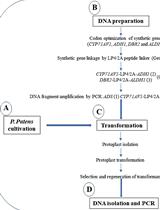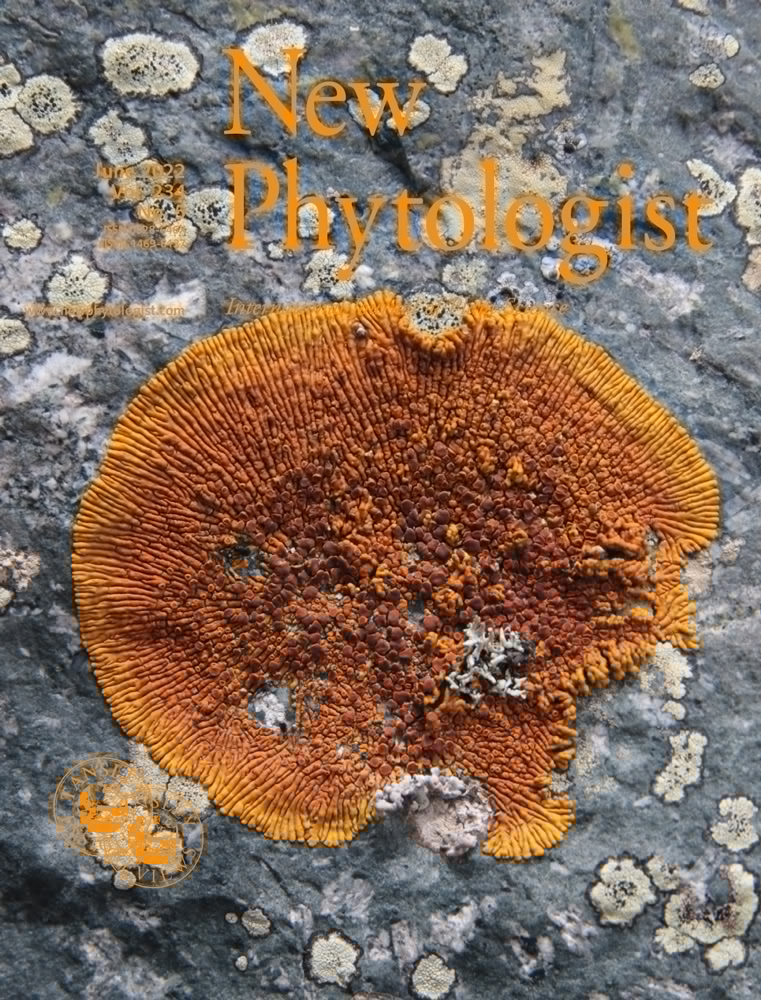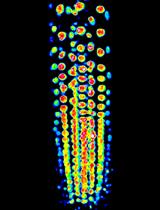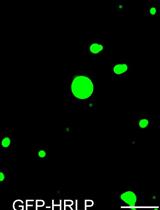- EN - English
- CN - 中文
Utilizing FRET-based Biosensors to Measure Cellular Phosphate Levels in Mycorrhizal Roots of Brachypodium distachyon
利用基于FRET的生物传感器测量丛枝菌根共生黑麦草根中的细胞磷水平
发布: 2025年01月20日第15卷第2期 DOI: 10.21769/BioProtoc.5158 浏览次数: 1415
评审: Demosthenis ChronisJuliane K IshidaAnonymous reviewer(s)

相关实验方案

通过在体内直接组装多个DNA片段在青蒿中异源生产青蒿素
Nur Kusaira Khairul Ikram [...] Henrik Toft Simonsen
2023年07月20日 1347 阅读
Abstract
Arbuscular mycorrhizal (AM) fungi engage in symbiotic relationships with plants, influencing their phosphate (Pi) uptake pathways, metabolism, and root cell physiology. Despite the significant role of Pi, its distribution and response dynamics in mycorrhizal roots remain largely unexplored. While traditional techniques for Pi measurement have shed some light on this, real-time cellular-level monitoring has been a challenge. With the evolution of quantitative imaging with confocal microscopy, particularly the use of genetically encoded fluorescent sensors, live imaging of intracellular Pi concentrations is now achievable. Among these sensors, fluorescence resonance energy transfer (FRET)-based biosensors stand out for their accuracy. In this study, we employ the Pi-specific biosensor (cpFLIPPi-5.3m) targeted to the cytosol or plastids of Brachypodium distachyon plants, enabling us to monitor intracellular Pi dynamics during AM symbiosis. A complementary control sensor, cpFLIPPi-Null, is introduced to monitor non-Pi-specific changes. Leveraging a semi-automated ImageJ macro for sensitized FRET analysis, this method provides a precise and efficient way to determine relative intracellular Pi levels at the level of individual cells or organelles.
Key features
• This protocol describes the use of FRET biosensors for in vivo visualization of spatiotemporal phosphate levels with cellular and subcellular resolution in Brachypodium distachyon.
• An optimized growth system can allow tracing of Pi transfer between AM fungi and host root.
Keywords: Arbuscules (丛枝吸胞)Background
Arbuscular mycorrhizal (AM) fungi establish one of the most prevalent mutualistic relationships with plants, primarily delivering phosphorus in the form of phosphate (Pi) to their hosts for carbon in return. The symbiosis is characterized by AM fungal hyphae penetrating the root epidermis, progressing through the root to the cortex, and forming arbuscules within cortical cells. The arbuscules, intricate tree-like structures, serve as the primary sites for nutrient exchange.
Mycorrhizal roots contain a diverse array of cortical cell conditions including cells hosting intracellular hyphae and cells containing arbuscules at different stages of development, from initiation to maturity and eventual collapse [1,2]. This diversity in arbuscule development across the cortical cells is predicted to result in variation in Pi transfer, as periarbuscular membrane-resident Pi transporters show arbuscule stage–specific expression [3–6]. Therefore, variance in Pi content in these cells is anticipated. In addition, plastids in certain colonized cells become highly stromulated [7,8], suggesting increased metabolic activity that may result in intracellular shifts in Pi levels.
Furthermore, the process of Pi uptake in mycorrhizal roots markedly contrasts with that of non-mycorrhizal roots. While non-mycorrhizal roots absorb Pi through their epidermal cells, transporting it apoplastically and/or sequentially to the cortex, endodermis, and vasculature, mycorrhizal roots receive Pi uptake directly into their inner cortical cells before moving it to the endodermis and vasculature [5,6]. Epidermal Pi transporter gene expression is downregulated in mycorrhizal roots, suggesting that the epidermis in mycorrhizal roots plays a less significant role in Pi absorption [9–11]. Given these distinct pathways for Pi uptake, investigating the cellular Pi response dynamics within mycorrhizal roots is likely to provide new insights into root Pi distribution and homeostasis.
Genetically encoded fluorescent sensors have emerged as powerful tools for monitoring analytes with cellular resolution [12,13]. These fluorescent sensors can be introduced into plants and expressed from constitutive or tissue/cell-type-specific promoters. They have the ability to bind reversibly to their analytes, translating their abundance into fluorescence changes. This facilitates real-time monitoring of molecular changes at intracellular or subcellular levels. Biosensors, targeting ions like Ca2+, H+, and Zn2+, as well as hormones such as ABA and auxin, and monitoring protein activities such as nitrate transporters, have been created and used in plants [12]. Their application has advanced knowledge of ion and hormone dynamics during plant development and in response to abiotic stress [13–15].
Among the various biosensors, fluorescence resonance energy transfer (FRET)-based sensors have proven especially reliable [12,13]. FRET occurs when a donor and an acceptor fluorescent molecule are in close proximity, and there is spectral overlap between the donor emission and the acceptor excitation; energy then transfers from the excited donor to the acceptor, quenching the donor’s fluorescence and potentially enhancing fluorescence of the acceptor. FRET biosensors generally feature a ligand-binding domain attached to two green fluorescent protein (GFP) spectral variants, typically cyan (CFP) and yellow (YFP). When the ligand binds, it triggers a conformational change that alters the proximity of the donor and acceptor and affects the FRET efficiency. This change is observed as a shift in the intensity ratio of the two fluorescent proteins, termed the FRET ratio [13]. The observed ratio directly corresponds to the ligand concentration within a range defined by the binding affinity and, ultimately, by the sensor's saturation point [16–18]. Furthermore, FRET-sensitized emission is a valuable method to measure FRET; adjusting for issues like donor spectral bleed-through and acceptor cross-excitation allows a precise determination of FRET-derived acceptor fluorescence [19–21]. Such adjustments are vital when analyzing ligand concentrations across various cell types or comparing data from different samples to pinpoint gene or protein roles.
To measure Pi content in mycorrhizal roots, we introduced a Pi biosensor, cpFLIPPi-5.3m, into Brachypodium distachyon plants and targeted it to the cytosol or plastid [22]. In each case, we included a control sensor, cpFLIPPi-Null, which has a mutation that prevents Pi binding. These sensors had previously been optimized and used successfully to monitor intracellular Pi content in Arabidopsis thaliana [23,24]. The authors had shown that the control sensor is Pi-independent and any FRET ratio shifts reflect non-Pi specific changes, such as intracellular ionic shifts. Thus, when the control sensor exhibits no FRET ratio shift, it suggests that the observed changes in the Pi sensor are genuinely due to intracellular Pi fluctuations. This study outlines our method of employing these sensors to track Pi dynamics during AM symbiosis and our use of a semi-automated ImageJ macro to efficiently extract quantitative data for sensitized FRET analysis.
Materials and reagents
Biological materials
1. All Brachypodium distachyon (line Bd21-3) transgenic lines used in this protocol can be obtained from Maria Harrison’s lab (under a Boyce Thompson Institute Material Transfer Agreement). The lines are grouped into categories as follows:
a. For the quantification of cytosolic Pi levels:
Transgenic lines expressing the sensor and its controls from a mycorrhiza-inducible, cell-type-specific promoter, BdPT7. Fluorescent signals from these lines are only from cells containing arbuscules.
BdPT7::cpFLIPPi-5.3m
BdPT7::cpFLIPPi-Null
BdPT7::eCFP
BdPT7::cpVenus
WT (used as a negative control to remove the potential background during image analysis)
All lines are needed for Pi imaging for each experiment.
Transgenic lines expressing the sensor and controls from the constitutive promoter ZmUb1 promoter. Fluorescent signals from these lines occur in all cell types. We failed to generate a ZmUb1::cpVenus line so the BdPT7::cpVenus is used as one of the controls for ZmUb1::cpFLIPPi-5.3m.
ZmUb1::cpFLIPPi-5.3m
ZmUb1::cpFLIPPi-Null
ZmUb1::eCFP
BdPT7::cpVenus
WT (used as a negative control to remove the potential background during image analysis)
b. For the quantification of plastidic Pi levels:
Transgenic lines expressing a plastid-targeted sensor and its controls from the BdPT7 promoter. Fluorescent signals from these lines occur in the plastid only in cells containing arbuscules.
BdPT7::plastid-cpFLIPPi-5.3m
BdPT7::plastid-cpFLIPPi-Null
BdPT7::plastid-eCFP
BdPT7::plastid-cpVenus
WT (used as a negative control to remove the potential background during image analysis)
2. AM fungal spores. Diversispora epigaea is used in the protocol as an example. It can be obtained from the International Collection of (Vesicular) Arbuscular Mycorrhizal Fungi (INVAM). Other species of AM fungi are also available from this collection. We have also used these lines successfully with Rhizophagus irregularis. A commercial vendor, Premier Tech (Canada), can supply Rhizophagus irregularis (ready-for-use spores).
Reagents
1. Bleach (Pure Bright, containing 5%–7% sodium hypochlorite)
2. Sterile deionized water
3. Agar (Millipore-Sigma, catalog number: A7921)
4. Benomyl [Methyl 1-(butylcarbamoyl)-2-benzimidazolecarbamate] (Millipore-Sigma, catalog number: 381586)
5. Ca(NO3)2·4H2O (calcium nitrate tetrahydrate) (Millipore-Sigma, catalog number: C2786-500G)
6. KNO3 (potassium nitrate) (Millipore-Sigma, catalog number: 221295-100G)
7. MgSO4·7H2O (magnesium sulfate heptahydrate) (Millipore-Sigma, catalog number: 221295-100G)
8. NaFeEDTA [ethylenediaminetetraacetic acid iron(III) sodium salt] (Millipore-Sigma, catalog number: EDFS-100G)
9. KH2PO4 (potassium phosphate monobasic) (Millipore-Sigma, catalog number: P0662-25G)
10. H3BO3 (boric acid) (Millipore-Sigma, catalog number: B0394-100G)
11. Na2MoO4·2H2O (sodium molybdate dihydrate) (Millipore-Sigma, catalog number: 331058-5G)
12. ZnSO4·7H2O (zinc sulfate heptahydrate) (Millipore-Sigma, catalog number: 221376-100G)
13. MnCl2·4H2O [manganese(II) chloride tetrahydrate] (Millipore-Sigma, catalog number: 221279-100G)
14. CuSO4·5H2O [copper(II) sulfate pentahydrate] (Millipore-Sigma, catalog number: 209198-5G)
15. CoCl2·6H2O [cobalt(II) chloride hexahydrate] (Millipore-Sigma, catalog number: 255599-5G)
16. HCl (hydrochloric acid) (Millipore-Sigma, catalog number: 258148-25ML)
17. MES (C6H13NO4S) (Millipore-Sigma, catalog number: M3671-50G)
18. NaOH (sodium hydroxide) (Millipore-Sigma, catalog number: 221465-500G)
Solutions
1. Modified 1/4 strength Hoagland solution with 20 μM potassium phosphate (see Recipes)
Recipes
1. Modified 1/4 strength Hoagland solution with 20 μM potassium phosphate
| Reagent | Final concentration | Note |
|---|---|---|
| Ca(NO3)2·4H2O | 1.25 mM | |
| KNO3 | 1.25 mM | |
| MgSO4·7H2O | 0.5 mM | |
| NaFeEDTA | 0.025 mM | |
| KH2PO4 | 0.02 mM | The phosphate levels can be varied by adjusting the amount of this reagent. |
| H3BO3 | 5 μM | |
| Na2MoO4·2H2O | 0.12 μM | |
| ZnSO4·7H2O | 0.5 μM | |
| MnCl2·4H2O | 1 μM | |
| CuSO4·5H2O | 0.25 μM | |
| CoCl2·6H2O | 0.19 μM | |
| HCl | 6.25 μM | |
| MES (C6H13NO4S) | 0.25 mM |
Adjust the final pH to 6.1 using NaOH.
Laboratory supplies
1. 14 mL culture polypropylene tubes (MTC-Bio, catalog number: UX-34501-06)
2. Regular-weight seed germination paper (Anchor Paper Co, catalog number: SD3815L)
3. Sterile Petri dish (100 × 10, Carolina, catalog number: 741248; 100 × 20 mm, Carolina, catalog number: 741252; a large one, approximately 14 cm in diameter, used for washing substrate from roots)
4. Parafilm (Sigma-Aldrich, catalog number: P7543)
5. 20 cm plastic cones (Stuewe & Sons, Inc., catalog number: SC10U)
6. 9 cm (3-1/2”) diameter plastic pot (Flinn Scientific, catalog number: FB0652)
7. Humidity domes (Global Industrial, catalog number: CK64081)
8. Growth substrate (for example, sand, gravel, or turface, which can be purchased from a general supplier, e.g., Lowes or Home Depot)
9. MF Millipore membrane filter, 0.45 μm pore size (Millipore-Sigma, catalog number: HAWP9000)
10. Microscope slides (ideally 75 mm × 25 mm, Carolina, catalog number: 632010) and coverslips (ideally 20 mm × 20 mm, Carolina, catalog number: 633009)
11. Aluminum foil
12. Fine tip tweezers (Fisherbrand, catalog number: 12-000-122)
13. A digital camera or other device that can take photos, such as a personal cell phone
14. Spray bottles (UNLINE, catalog number: S-11686)
Equipment
1. Class I laminar flow hood (e.g., Thermo Scientific HeraguardTM ECO Clean Bench, catalog number: 51029701)
2. Growth chambers or greenhouses to grow plants (e.g., Conviron reach-in growth chamber, model: PGR15)
3. Stereomicroscope (Olympus, model: SZX-12)
4. Upright confocal microscope (Leica, model: SP5), see General note 1 for details
Software and datasets
1. Fiji (ImageJ, free, no license needed, can be downloaded via the link: https://imagej.net/downloads)
The sensitized FRET analysis Macro can be copied via the link: https://nph.onlinelibrary.wiley.com/action/downloadSupplement?doi=10.1111%2Fnph.18081&file=nph18081-sup-0001-SupInfo.pdf)
Procedure
文章信息
稿件历史记录
提交日期: Sep 4, 2024
接收日期: Nov 10, 2024
在线发布日期: Dec 3, 2024
出版日期: Jan 20, 2025
版权信息
© 2025 The Author(s); This is an open access article under the CC BY-NC license (https://creativecommons.org/licenses/by-nc/4.0/).
如何引用
Zhang, S., Jurgensen, L. and Harrison, M. J. (2025). Utilizing FRET-based Biosensors to Measure Cellular Phosphate Levels in Mycorrhizal Roots of Brachypodium distachyon. Bio-protocol 15(2): e5158. DOI: 10.21769/BioProtoc.5158.
分类
植物科学 > 植物新陈代谢 > 其它化合物
生物化学 > 蛋白质 > 荧光
您对这篇实验方法有问题吗?
在此处发布您的问题,我们将邀请本文作者来回答。同时,我们会将您的问题发布到Bio-protocol Exchange,以便寻求社区成员的帮助。
提问指南
+ 问题描述
写下详细的问题描述,包括所有有助于他人回答您问题的信息(例如实验过程、条件和相关图像等)。
Share
Bluesky
X
Copy link










